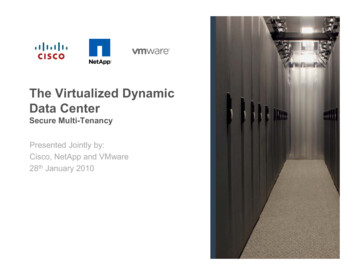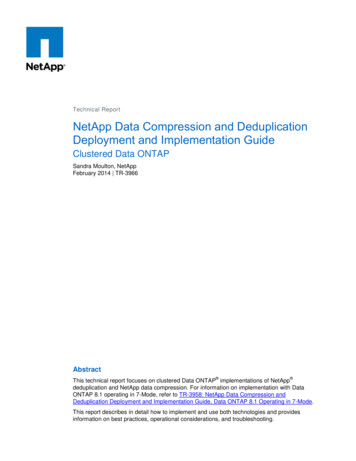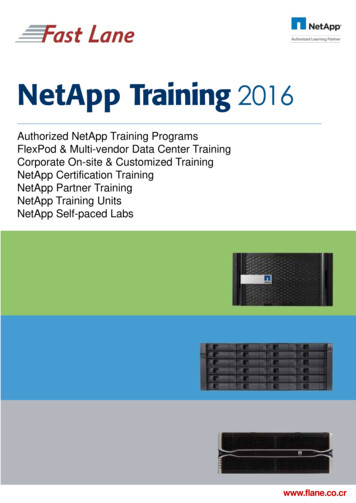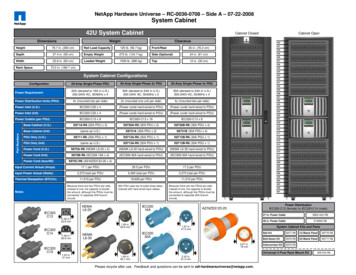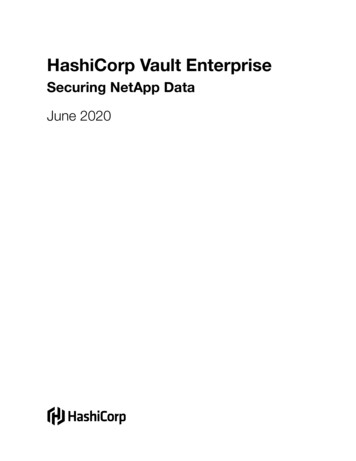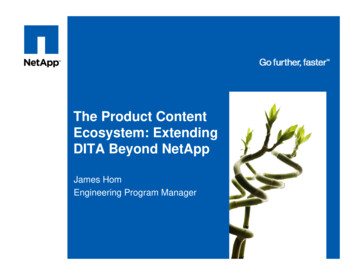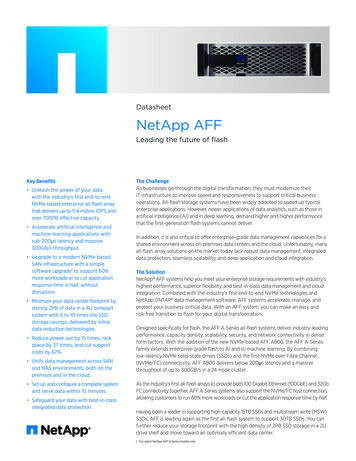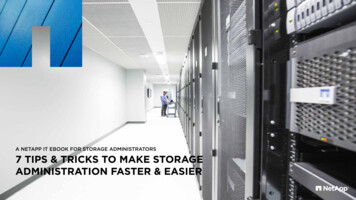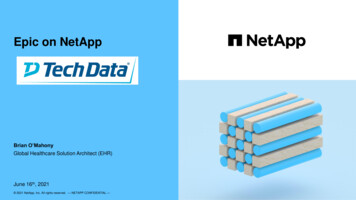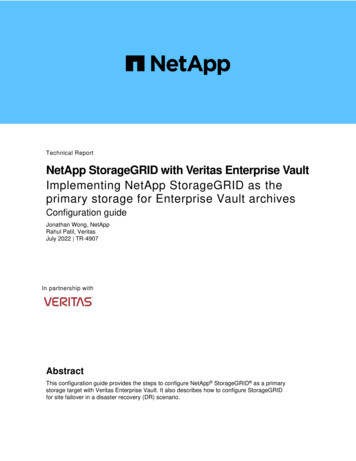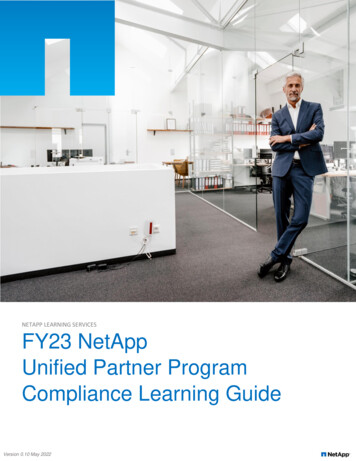
Transcription
Technical ReportNetApp E-Series and NVMe over FabricsSupportNonvolatile Memory Express over InfiniBand, RoCE, andFibre Channel on E-Series SystemsAbdel Sadek, Chuck Nichols, Joey Parnell, Scott Terrill, Steve Schremmer, Amine Bennani,And Tish Best, NetAppSeptember 2019 TR-4766AbstractThe NetApp EF600 all-flash array with SANtricity OS 11.60, NetApp EF570 all-flash array,and NetApp E5700 system with SANtricity OS 11.50.2 support the new Nonvolatile Memoryover Fabrics (NVMe-oF) protocol using either InfiniBand (IB), RDMA over ConvergedEthernet (RoCE) or Fibre Channel (FC) connections. This report provides technical detailsfor the implementation, benefits, and limitations of this system. It also compares SCSI andNVMe-oF structures.
TABLE OF COTNENTS1Introduction . 32NVMe-oF Ecosystem . 33Transport Layers: InfiniBand, RoCE, and FC . 44NVMe and NVMe-oF: Protocols and Concepts . 454.1Command Set and Transport Protocol .44.2NVMe Concepts .54.3Command Sets .94.4Host Driver and Tools .114.5Frequently Asked Questions .15Conclusion . 15Where to Find Additional Information . 15Version History . 16LIST OF TABLESTable 1) Historical E-Series transport protocol and command set combinations. .5Table 2) E-Series supported admin commands. .10Table 3) E-Series supported NVM commands. .10Table 4) E-Series supported fabrics commands. .11Table 5) Some useful NVMe CLI commands. .14LIST OF FIGURESFigure 1) NVMe-oF front end on the EF570/E5700 E-Series systems. .3Figure 2) NVMe end-to-end on the EF600 E-Series system. .3Figure 3) NVMe-oF host/array topology with logical NVMe controllers. .7Figure 4) Namespace ID mapping to host groups. .8Figure 5) NVMe controller queue pairs. .9Figure 6) Linux OS driver structure. .12Figure 7) Coexistence between NVMe/FC and FC. .13Figure 8) Coexistence between NVMe/IB, iSER, and SRP on the host side. .13Figure 9) Coexistence between NVMe/RoCE and iSCSI. .142NetApp E-Series and NVMe Over Fabrics Support 2019 NetApp, Inc. All rights reserved. NETAPP CONFIDENTIAL
1 IntroductionNonvolatile Memory Express (NVMe) has become the industry standard interface for PCIe solid-statedisks (SSDs). With a streamlined protocol and command set and fewer clock cycles per I/O, NVMesupports up to 64K queues and up to 64K commands per queue. These attributes make it more efficientthan SCSI-based protocols like SAS and SATA.The introduction of NVMe over Fabrics (NVMe-oF) makes NVMe more scalable without affecting the lowlatency and small overhead that are characteristic of the interface.NetApp E-Series support for NVMe-oF started first in 2017 with NVMe/IB on the EF570 and E5700followed by NVMe/RoCE support in 2018. NVMe/FC was added in 2019. NVMe-oF is supported from thehost to the front end of the NetApp EF570 all-flash array or the E5700 hybrid array, while the back end isstill SCSI-based with SAS drives, as shown in Figure 1.With the introduction of the new NetApp EF600 all-flash array, NetApp E-Series now offers end-to-endsupport for NVMe from the front end all the way to the drives, as shown in Figure 2.Figure 1) NVMe-oF front end on the EF570/E5700 E-Series systems.Figure 2) NVMe end-to-end on the EF600 E-Series system.2 NVMe-oF EcosystemNetApp is a promoter of the NVMexpress.org committee, which manages the NVMe and NVMe-oFspecifications. In addition, NetApp actively collaborates with different partners at the engineering level,3NetApp E-Series and NVMe Over Fabrics Support 2019 NetApp, Inc. All rights reserved. NETAPP CONFIDENTIAL
including operating system vendors such as Red Hat and SUSE, along with hardware vendors such asMellanox and Broadcom. The E-Series Interoperability team is also working with the University of NewHampshire for potential certification at NVMe Plugfest events.3 Transport Layers: InfiniBand, RoCE, and FCThe NVMexpress.org specifications outline support for NVMe-oF over remote direct memory access(RDMA) and FC. The RDMA-based protocols can be either IB or RDMA over Converged Ethernet version2 (RoCE v2). Throughout this document, whenever NVMe/RoCE is mentioned, version 2 is impliedwhether it’s explicitly noted or not.The NetApp E-Series implementation supports NVMe/IB, NVMe/RoCE v2, and NVMe/FC with benefitsincluding but not limited to the following capabilities: The E-Series storage already supports FC as a transport layer for SCSI protocol commands.NVMe/FC adds a new protocol over such well-established transport layer. The same hardware on the NetApp EF600, EF570, and E5700 arrays that runs FC can run NVMe/FC(although not at the same time). Both protocols (FC and NVMe/FC) can coexist on the same fabric and even on the same FC host busadapter (HBA) port on the host side. This capability allows customers with existing fabrics running FCto connect the NetApp EF600, EF570, or E5700 arays running NVMe/FC to the same fabric. All FC components in the fabric (NetApp EF600, EF570, and E5700 storage systems, switches, andHBAs) can negotiate the speed down as needed: 32Gbps; 16Gbps; and 8Gbps. A lower speedmakes it easier to connect to legacy components. IB and RoCE have RDMA built into them. E-Series storage already has a long history of supporting other protocols over RDMA (SCSI-based),such as iSCSI Extensions for RDMA (iSER) and SCSI RDMA Protocol (SRP). The same host interface card on the EF570 and E5700 arrays can run iSER, SRP, NVMe/IB orNVMe/RoCE, although not at the same time. The same host interface card on the NetApp EF600 array can run NVMe/IB or NVMe/RoCE, althoughnot at the same time. All three protocols (iSER, SRP, and NVMe/IB) can coexist on the same fabric and even on the sameInfiniBand host channel adapter (HCA) port on the host side. This capability allows customers withexisting fabrics running iSER and/or SRP to connect the EF600, EF570 or E5700 arrays runningNVMe/IB to the same fabric. Both iSCSI and NVMe/RoCE can coexist on the same fabric on the host side. The NetApp EF600, EF570, and E5700 arrays support 100Gbps, 50Gbps, 40Gbps, 25Gbps, and10Gbps speeds for NVMe/RoCE. The NetApp EF600, EF570, and E5700 arrays support NVMe/RoCE v2 (which is routable), and theyare also backward compatible with RoCE v1. All IB components in the fabric (NetApp EF600, EF570, and E5700 storage systems, switches, andHCAs) can negotiate the speed down as needed: Enhanced Data Rate (EDR) 100Gbps; FourteenData Rate (FDR) 56Gbps; or Quad Data Rate (QDR) 40Gbps. A lower speed makes it easier toconnect to legacy components.4 NVMe and NVMe-oF: Protocols and Concepts4.1Command Set and Transport ProtocolThis document uses the following definitions:4NetApp E-Series and NVMe Over Fabrics Support 2019 NetApp, Inc. All rights reserved. NETAPP CONFIDENTIAL
Command set. The set of commands used for moving data to and from the storage array andmanaging storage entities on that array. Transport protocol. The underlying physical connection and the protocol used to carry thecommands and data to and from the storage array.Since its inception, E-Series storage software was designed to provide SCSI command set storagefunctionality. Over the years, this software has been extended, architecturally and functionally, to supportadditional SCSI transport protocols. However, in all cases, it has remained fundamentally a SCSI product.Therefore, it has historically been unnecessary to distinguish between the concept of the supportedcommand set and the concept of the underlying transport protocol. That is, because E-Series hastraditionally been a SCSI product, the fact that it supports a FC host/fabric connect implies that it supportsthe FCP SCSI protocol carried by the FC transport protocol.Table 1 lists the transport protocol and command set combinations supported by E-Series storageproducts. Historically, despite the variations in underlying transport mechanisms, SCSI has been thecommand set in use in every case.Table 1) Historical E-Series transport protocol and command set combinations.Physical ConnectionTransport ProtocolCommand SetParallel SCSI busSCSISCSIFCFC SCSI Protocol (FCP)SCSISerial-attached SCSISerial SCSI Protocol (SSP)SCSIEthernetInternet SCSI Protocol (iSCSI)SCSIIBSCSI RDMA Protocol (SRP)SCSIIBiSCSI extensions for RDMA (iSER)SCSIInfiniBandNVMe-oF (NVMe/IB)NVMeRDMA over Converged EthernetNVMe-oF (NVMe/RoCE)NVMeFCNVMe-oF (NVMe/FC)NVMeThe E-Series storage software SANtricity OS now supports a command set other than SCSI: NVMe-oF.The 11.40 release of SANtricity OS supports the IB NVMe transport protocol on the EF570 and E5700,and the 11.50 release also supports the RoCE v2 NVMe transport protocol on the same systems. The11.50.2 release adds support for FC as a third NVMe transport protocol on the same systems. Finally, the11.60 introduces the new NetApp EF600 all-flash array with support for all three NVMe transportprotocols.4.2NVMe ConceptsNVMeNVMe is a specification-defined, register-level interface for applications (through OS-supplied file systemsand drivers) to communicate with nonvolatile memory data storage through a PCI Express (PCIe)connection. This interface is used when the storage devices reside in the same physical enclosure, andthe host OS and application can be directly connected through PCIe, such as
Serial-attached SCSI Serial SCSI Protocol (SSP) SCSI Ethernet Internet SCSI Protocol (iSCSI) SCSI IB SCSI RDMA Protocol (SRP) SCSI IB iSCSI extensions for RDMA (iSER) SCSI . NVMe-oF is a specification-defined extension to NVMe that enables NVMe-based communication over interconnects other than PCIe. This interface makes it possible to connect .
